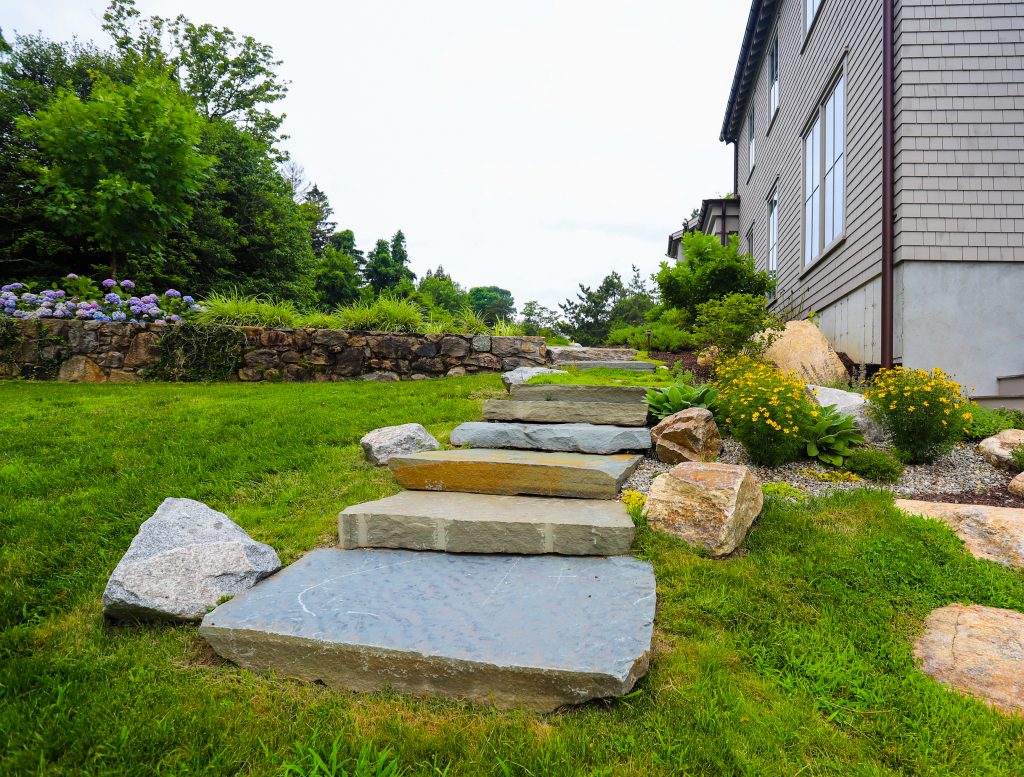What is contemporary landscape design? Of course, let us preface by saying, art is subjective. When we think about modern architecture, we might conjure images of minimalist, clean lines, and a borderline austere aesthetic. When we think about contemporary landscape design, our design perspective transcends aesthetics. Modern landscape design solves a problem – many problems – associated with decades of poor land development, pollution, and destruction of critical habitats. Modern landscape design is a holistic examination of land use, function and ecosystem services.

Contemporary Ecological Landscaping for Modern Architecture
Designing landscapes in 2021 requires not only an eye for beauty but a brain for ecological restoration. This property in Darien, CT is proof that a naturalistic and ecological landscape design style looks fabulous against a modern, custom-built home of today’s styling. Natural landscapes are not just for the cottage in country. Every building looks at home nestled amongst a natural landscape, where birds nest, butterflies drink nectar and carbon is sequestered by the layers of plant material. Designing native landscapes makes the home look like it’s been grounded in the landscape for years; it just belongs, right at home in its native ecosystem.

Assessing & Amending Site Conditions
As this was a new construction, we found much of the property’s soil was contaminated with extremely poor, construction debris – making it alkaline – and very compacted. We created an engineered soil that improved the organic matter, pH and overall growing environment for the planting design.


We always assess the existing plant material on a property. At this site, we found that many of the existing shrubs – hydrangeas, azaleas, and rhododendrons – were suffering because they were planted in a spot with too much sun exposure. The stressed plants then suffered from a lace bug infestation which nearly defoliated the leaves completely. Mature shrubs, even those that aren’t native, serve an ecological purpose – sequestering carbon in their woody tissue. We opted to transplant these shrubs from highly exposed front yard to a shadier corner in the backyard, where this season they bloomed for the first time in years.

We also decided to transplant existing birch trees from the front circular bed in the driveway to the rear landscape. In the previous spot, they blocked and detracted from the impressive architecture of the home. We proposed replacing the birches with a colorful grass and perennial garden to accentuate the entrance. Birches are one of the most ecologically valuable native trees – attracting 413 species of lepidoptera, according to Doug Tallamy.

Seeding for the Future
Part of ecological landscape design is always looking for areas to add/expand garden beds and increase the density of ecologically productive plants. One example on this property is the new bed beneath the mature trees we designed. The existing weeds and brush were removed by hand before seeding the area with several seed mixes. We included oats and rye grass as a cover crop, plus some annuals for color in the first year. Some of the species in the New England Wildflower mix we used will take 2-4 years to flower, so having some faster growing crops is important for soil stabilization. These native perennials will provide critical habitat for pollinators and birds for years to come.

Designing to Combat Climate Change
Even the foundation plantings were designed as their own microhabitats, featuring flowering shrubs that are pollinator magnets, native perennials, grasses and ferns. The increase in overall biomass from the plant material means an increase in greenhouse gas sequestration capacity. The dense planting will also help uptake storm water during storm events – plants have a much higher absorption rate than lawn does. This is important because water is a precious resource and stormwater runoff quickly becomes polluted and drains into oceans.

We also worked to reinvigorate an existing meadow that had been mismanaged, causing it to lose much of the plant diversity. Catch up on our previous blog – Native Wildflower Meadow Management in Darien, CT.
As you can see, this design, while beautiful, is also serving multiple ecological functions. Designing landscapes in 2021 means not only creating beautiful spaces for our clients, but also addressing some of our most pressing environmental issues head on. We do not have much more time to spare.
Contact us to start your ecological landscape design consultation.